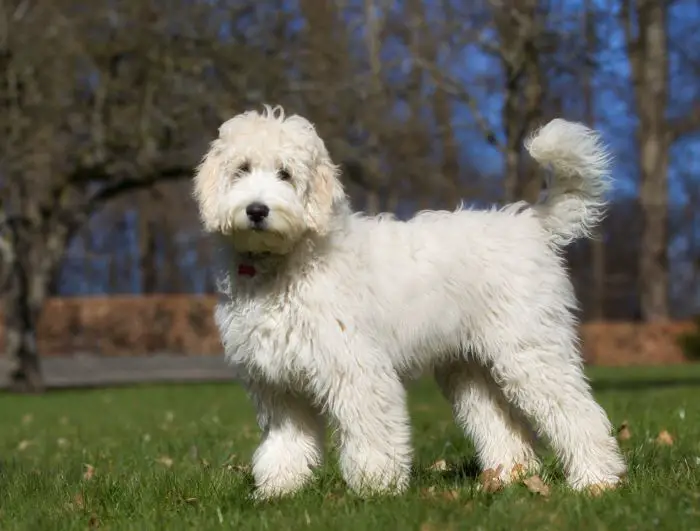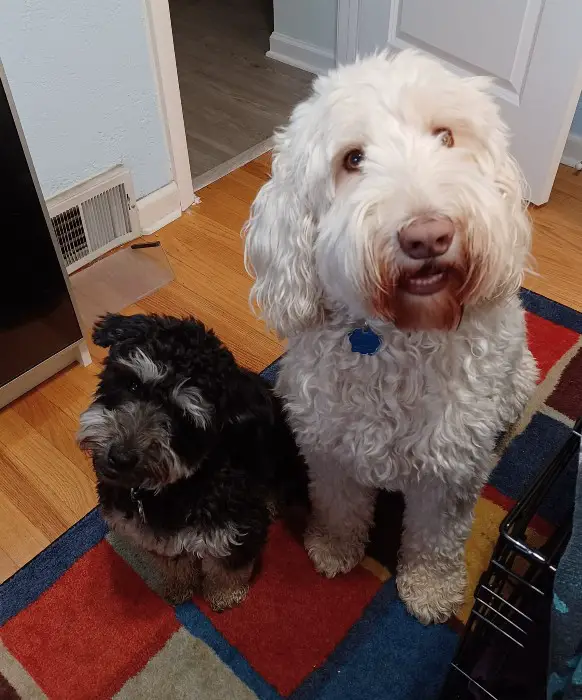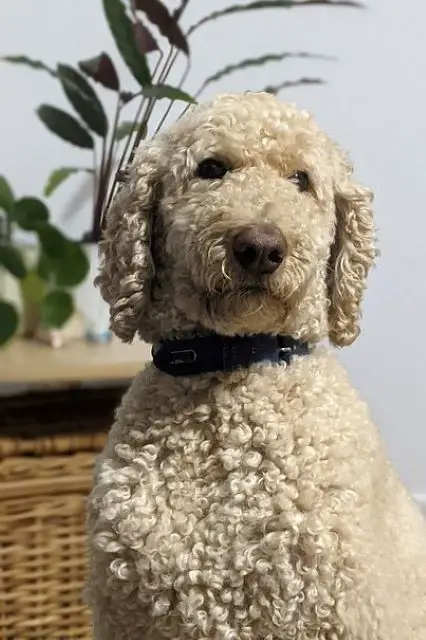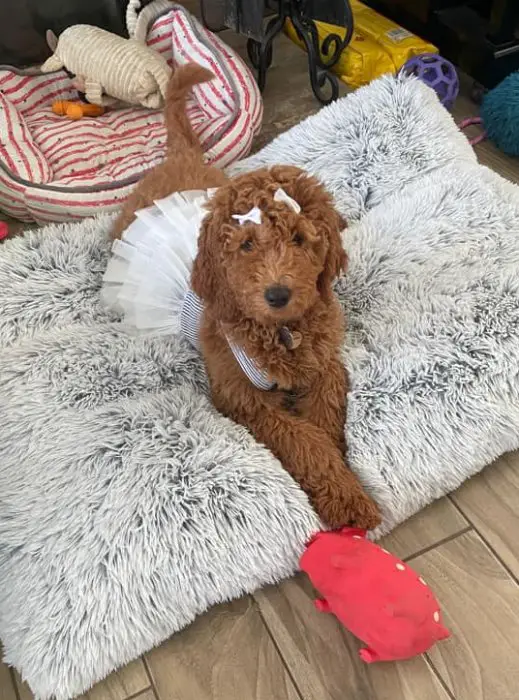Labradoodles are a great choice of dog. But there is a lot of variety amongst Labradoodle generations. What exactly is the difference in size, coat, and temperament between Labradoodle generations? Which one is the best choice for you? By the end of this article, you’ll understand all of this and more.

Labradoodle generations are illustrated using “F” to represent filial generation and “b” to indicate backcrossing. F1, F2, and other Labradoodles with no backcrossing are usually 50% Poodle and 50% Labrador Retriever. With every instance of backcrossing, the amount of Labrador Retriever genetics halves – with F1b Labradoodles being 25% and F2bb Labradoodles being 12.5% – making these dogs desirable to those who want more Poodle-like coats for allergies or appearance preferences.
This can be rather confusing without a prior understanding of some genetics. So let’s delve deeper into the generation labels and how these generations can affect your Labradoodle’s appearance and temperament.
Labradoodle Generation “F” and “b” Explained
Generations of most hybrid dogs are denoted with an “F,” which stands for filial. In other words, it refers to the number of generations between your Labradoodle and a purebred Labrador Retriever and Poodle.
The first filial generation, or the first time the parent breeds are combined, is the F1 generation, also known as first generation. If two of these are bred together, you get an F2, also called second generation.
If different filial generation Labradoodles are bred together, the ‘youngest’ generation of Labradoodle will influence the generation of the offspring. For example, if an F1 and F2 Labradoodle are bred together, offspring are considered F2, instead of F3.
Backcrossing with one of the original parent breeds is denoted with a “b”. If an F1 Labradoodle is bred with a Poodle, the offspring will be an F1b Labradoodle. If one of these is backcrossed again, it becomes an F1bb Labradoodle.
This can go on indefinitely.
How Generation Affects Labradoodles

Labradoodle Generation and Health
Labradoodles, like most other hybrid breeds, can benefit from hybrid vigor. In short, this means that the new hybrid will be healthier than the parent breeds. This can also be known as an outbreeding enhancement.
In these cases, recessive diseases are impossible to express because both parents are not at risk of carrying them. But, this advantage disappears with later generations.
Labradoodle Generation and Size
Along with hybrid vigor affecting the health of a Labradoodle, it will also affect its size, with early generations being bigger than their parents.
Other genetic components such as the size of the parent breeds affect the size of your Labradoodle too. If you breed using miniature Poodles and keep backcrossing with smaller dogs, your Labradoodle will end up smaller.
Labradoodle Generation and Coat
Labradoodle generation can greatly affect coats. Backcrossing is often done with a Poodle to make the Labradoodle as hypoallergenic as possible. This increase in Poodle genetics makes the coats more curly.
You can read more on Labradoodle Coat Types here.
Labradoodle Generation and Temperament
There is a lot more than the generation that can influence the temperament of a Labradoodle. But the effect of generation should not be overlooked.
Especially when working breeds of Poodles and Labrador Retrievers are used in the breeding process, an increase in the genetic material of either parent will influence the behavior and instincts of your Labradoodle.
Labradoodle Generation Summary
| Labradoodle Type | Parent 1 | Parent 2 | Generation |
| F1 | Poodle | Labrador Retriever | 1st |
| F1b | F1 Labradoodle | Poodle (rarely Labrador Retriever) | 2nd |
| F1bb | F1b Labradoodle | Poodle (rarely Labrador Retriever) | 3rd |
| F2 | F1 Labradoodle | F1 Labradoodle | 2nd |
| F2b | F2 Labradoodle | Poodle (rarely Labrador Retriever) | 3rd |
Although Labradoodles can be backcrossed with Labrador Retrievers, there is little reason for breeders to do so. This is because the coat becomes more unfavorable.
Suppose there is demand for a specific temperament or other characteristics. In that case, this may happen, but for the sake of this article, I will assume any backcrossing is done with a Poodle.
Now that you understand how the different Labradoodle generations are created let’s look at why you might want them.
What is an F1 Labradoodle?

An F1 Labradoodle is the offspring of a Poodle and a Labrador Retriever. It is 50% of each parent breed. They are some of the most common Labradoodles you can find because they are quite easy to breed in terms of the time it takes.
Their coats can be a little bit unpredictable. But most of the time, it seems to be quite wavy and is also known as a fleece coat.
This wavy fleece coat is more hypoallergenic than that of a standard Labrador Retriever but will still shed a lot more than a Poodle.
If you like the shaggy look and don’t have terrible allergies, this is likely the best option, as it will be the healthiest Labradoodle variety in terms of hybrid vigor. Remember that they may be larger than some later generations, so choose your size appropriately.
What is an F1b Labradoodle?
An F1b Labradoodle occurs when an F1 Labradoodle is backcrossed with a Poodle. It is 75% Poodle. This creates rather stark differences between the two generations.
The most noticeable difference is in their coat. An F1b Labradoodle will have a far thicker and more curly coat. Waves may still appear, but the curling becomes more predictable based on the Poodles used in breeding.
The F1b Labradoodle still benefits from hybrid vigor, but not as much as the F1, and some recessive Poodle diseases may start to appear more often.
The F1b Labradoodle is the choice for you if you struggle with allergies but don’t like the very tight curls of an F1bb or the shaggy look of an F1 Labradoodle. Remember that their coats require a fair amount of grooming to prevent matting.
What is an F1bb Labradoodle?

An F1bb Labradoodle occurs when an F1b Labradoodle is backcrossed again, making it 87.5% Poodle.
These dogs do not benefit much from hybrid vigor. They are very Poodle-like in coat and temperament.
If you have severe allergies or like the tight-curled look of their coat but don’t want a Poodle, this is the best option for you. They can be a little bit more difficult to find, though.
What is an F2 Labradoodle?
An F2 Labradoodle is what happens when two F1 Labradoodles are bred. They look very similar to the F1 Labradoodle but do not benefit as much from hybrid vigor. There seems to be no obvious reason a breeder would want an F2 Labradoodle if they get a better dog in less time with an F1 Labradoodle. Many of these occur accidentally or through uneducated backyard breeders.
Multigeneration Labradoodle
Sorting Labradoodles by their genetic background is theoretically an endless task. You could get an F20 Labradoodle with enough time. And what about those that don’t quite fit into naming conventions, such as the offspring of a backcrossed and non-backcrossed Labradoodle?
In order to simplify things a little bit, Labradoodles and most other Poodle hybrids are called ‘multigenerational’ from the 3rd generation.
If the Labradoodle you are considering is labeled as multigenerational, make sure that you ask your breeder for more information, as this term is very diverse.
What to Consider Before Deciding on a Labradoodle Generation

There are many things that you need to carefully consider to determine which of the Labradoodle generations is the best for you.
Allergies
Do you, or does anyone in your household, suffer from allergies? If so, a curlier coat, something backcrossed with a Poodle, is likely the best option. F1b Labradoodles should be fine, but you’d be safest with an F1bb.
Grooming Requirements
Curlier, Poodle-like coats require a lot of grooming. If you want something with minimal brushing requirements, a dog with more Labrador Retriever is the better option. The F1 coat is the easiest to care for.
Appearance
There is nothing wrong with wanting a Labradoodle that looks a certain way. Make sure that you do your research beforehand and consult your breeder if a certain coat type appeals to you far more than any other.
The best option in these cases is to ask for pictures of previous litters with the same parents.
Related Reading:
